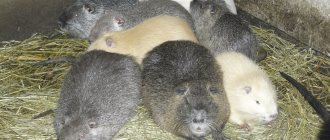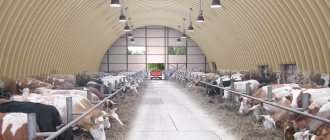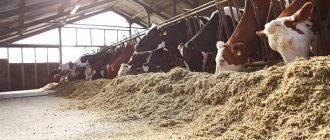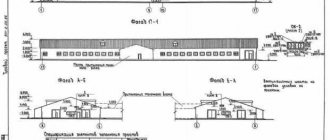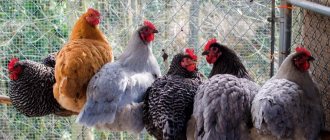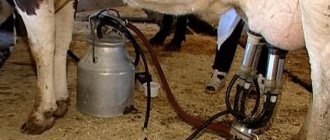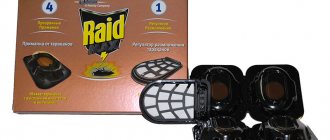Have you ever had a situation on a farm when, with a balanced diet and warm conditions, cows suddenly began to produce less milk or the quality of such milk yield significantly deteriorated? Agree, this is not a very pleasant situation. Especially if animals begin to get sick for no apparent reason.
For productive cattle keeping, the room must have a stable microclimate with proper air circulation. Increased humidity and temperature changes are most often the causes of decreased milk production and loss of live weight. This situation can be corrected if the exhaust system is properly designed and installed.
In this article we will tell you how to do barn ventilation with your own hands. Let's look at the existing types of exhaust systems and talk about how to select equipment for them.
What a barn should be like: general plan
The ceiling height should be at least 2.2 meters, and the width and length of the room should be 4 and 6 meters, respectively. The area is calculated based on the number of animals that will be kept in the barn, but the height of the ceilings is also taken into account so that the animals have enough air. For an adult cow, 20 m3 of the total volume of the room is enough, and for a calf - 10 m3.
The interior space is usually divided so that each animal has its own stall. The area of one stall should be at least 2.5 m2 (approximately 1.4 by 1.8-2 meters), and the height of the fence should be 1.5 m. The fence is made of strong boards that can withstand the weight of the cow.
When constructing a barn, it is taken into account that the opportunity for complete repairs is present only in the summer, when animals spend almost all their time in the pasture or under a canopy. During this period, a thorough inspection of the barn is carried out, cracks in the walls are sealed, insulation is carried out, as well as drinking bowls, feeders and partitions are repaired. The completely renovated room is disinfected and thoroughly ventilated.
Making a deflector for a ventilation riser
It is installed on a ventilation riser rising above the roof. The deflector works as follows: it cuts the wind directed in its direction, which leads to a decrease in pressure inside the device and increased draft in the exhaust duct.
Making your own wind turbine is inexpensive, but the effect is impressive. Install it on the roof. Before you start making it, you need to calculate the dimensions.
To calculate the height, the diameter of the ventilation pipe is multiplied by 1.7. By multiplying the diameter by 1.8, you get the width of the hood, and by multiplying this parameter by 1.3, you find out the required width of the diffuser.
The diagram shows typical structural components and standard proportions of a diffuser: pipe diameter (d), diffuser diameter (d1), hood circumference (d2), height (H)
Having calculated the dimensions, they are applied to cardboard and patterns are cut out. Next, the development of the cap, sketches of the diffuser blanks, cylinder and racks are transferred to a metal sheet or plastic. Using scissors, cut out all the parts and connect them using a special gun. All that remains is to install and secure the deflector.
You can also make a rotary valve yourself. To do this, a frame is welded from the corners. Holes are drilled on opposite sides of the frame and the axle is threaded through them. Bushings are made from pipe sections and welded.
A locking plate is made from a steel sheet according to the dimensions of the pipe. It is inserted into the frame and fixed to the axis by welding. To control the damper, a wooden handle is attached to the axis. To prevent the damper from closing spontaneously, a limiter is provided.
The disadvantage of such a ventilation system is the very fact of the presence of pipes in the room. From their surface, as well as from the perch, you will have to periodically scrape off droppings.
Basic rules for determining air exchange in a barn
Natural ventilation
To create a good microclimate, it is necessary to rely on the calculation of air exchange in an outbuilding. It depends on:
- air temperature inside the barn;
- indoor air humidity;
- supply air and time of year.
Calculation of air exchange based on air humidity is determined as follows:
L = Q x K + a / q1 – q2
- L – the amount of supply and exhaust air in the barn. The indicator determines how much air should enter or exit within 1 hour inside the building. The air volume indicator is expressed in m3. It maintains optimal humidity for animals – m3/1 hour
- Q – indicator of the level of evaporation released as a result of animal activity per hour – g/hour
- K – correction factor, determines the amount of moisture formed during the respiration of animals at different air temperatures
- a – premium, expressed as a percentage, depends on the intensity of moisture evaporation inside the barn.
- q1 – absolute humidity of air flows inside the building, g/m3.
- q2 – absolute humidity of supply air entering the barn, g/m3.
In order to determine the air exchange rate, it is necessary to know the total area of the barn. Then the air exchange (L) is divided by cubic capacity. You must adhere to the formula:
M = L Jan. / V (cubic capacity)
Using these formulas, you can calculate a system that allows you to achieve optimal conditions for keeping livestock. This is especially true in winter, when ventilation is carried out in a tethered barn. Animals are not allowed to go out into the open air. Therefore, in order for milk yield not to decrease, it is necessary not only high-quality feed, but also optimal temperature and air humidity.
Use of ventilation curtains and light aeration ridges
The equipment of such air exchange systems is used in large livestock farms and requires serious financial investments, as well as the involvement of professional designers and builders.
Installing adjustable curtains on sections of the wall allows them to be opened during the warm season, providing animals with free access to fresh air.
Such curtains can be vertical or horizontal, opening automatically or manually. Their material must be resistant to temperature changes, moisture and ammonia, and can also be easily cleaned from various contaminants.
Light-aeration ridges installed on the roof of a barn are strips of special roofing material that transmit sunlight and provide natural illumination to a modern livestock farm. During the hot season, special blinds are opened through which exhaust air is removed using through ventilation.
In each individual case, livestock breeders and farmers have the opportunity to independently choose which method of barn ventilation is most preferable for them.
Please like if the article was interesting and useful for you.
Types of ventilation systems for cattle
There are several variations of ventilation: forced, natural, and mixed. The choice of exhaust system depends on the size of the building, the number of livestock, climate conditions and other factors.
Cows can live comfortably if the area in the room per individual is at least 6 m² and the ceiling height is at least 2.5 m. There should also be an area for females with calves and a place for placing equipment.
The choice of material and technical base depends on the method of keeping cows. Typically the stall method is used, where cows stand in a designated area. With the pasture-stall method, animals can walk in a place prepared for them
Requirements for ventilation of barns are given in SNiP 2.10.03-84. The document specifies the basic requirements and calculation formulas for selecting equipment. By complying with the requirements of SNiP, the farmer will create comfortable conditions for keeping animals. The better the cows feel, the more milk they produce.
All types of ventilation systems have their own operating and installation characteristics. Incorrectly selected ventilation or incorrect placement of equipment can cause microclimate disturbances. Exhaust equipment should not cause drafts.
Next, we will consider in more detail the features of various types of ventilation.
Type #1 - natural system
The flow of fresh air is carried out through windows, cracks and door structures. Exhaust humid air is discharged through the ceiling.
To prevent dust from the street from entering the naturally ventilated barn, special cassette filters are installed at the inlet openings.
The advantages of natural ventilation include low cost of construction and simple installation. Despite the absence of additional energy costs, such an exhaust system also has a number of disadvantages.
Disadvantages of natural ventilation:
- difficult to calculate power;
- it is impossible to adjust the humidity level;
- presence of stagnant zones;
- drawing in dust and bacteria through open windows;
- dependence of the indoor microclimate on the weather.
It is permissible to use this type of ventilation only in private farms and farms with a small number of cows. At the same time, the waste products of cows must be removed in a timely manner, or the natural ventilation system will be of little use.
The operation of the natural exhaust system can be improved using special equipment: ventilation curtains , light ridge . Additional devices will improve the process of air inflow and outflow.
Ventilation curtains for barns
The product can have a rigid, semi-rigid or soft structure. Control of the curtain fabric can be automatic, manual, or mixed. Such structures are installed on various areas of the barn: windows, doors, roof, and walls.
Ventilation curtains are the optimal complement to a natural exhaust system. They help ensure a comfortable indoor microclimate and reduce electricity costs
Curtains can be made from various materials. The most commonly used variations are made of synthetic plastic. Some types of curtains are designed to completely shade the barn. There are also products that allow sunlight to pass through when closed.
Advantages of ventilation curtains:
- protection of the barn from the influence of the external environment;
- the ability to adjust the opening width of the canvas and create the required air flow;
- allow you to create climatic zones inside large rooms;
- can be used to create a thermal barrier.
Ventilation curtains are optimally suited for large livestock farms. Small barns can also be equipped with the device. This will allow you to quickly create comfortable conditions for keeping animals and significantly reduce energy costs.
Light skate in the barn
The equipment is made from translucent cellular polycarbonate. Mount the light ridge on the roof. It improves air exchange and lighting in the room.
The light skate is characterized by a long service life. Its frame is made of durable profile pipes. Thanks to this, the barn roof structure does not lose its rigidity.
The device of a light ventilation ridge will protect the barn from the penetration of strong wind, rain or snow into the room. The product facilitates the natural outflow of exhaust moist air.
Advantages of a light skate:
- Can be manufactured for any type of roof;
- improves the microclimate in the barn;
- protects equipment and structures from fungus formation;
- saves energy due to natural lighting;
- ensures the penetration of fresh air without drafts.
Polycarbonate sheets have good insulating properties. The material is resistant to friction and scratches. He is not afraid of temperature changes. These properties allow the light skate to be used for a long time.
Type #2 - forced ventilation
To ensure forced ventilation, fans are installed in the barn, as well as special valves . The system allows you to effectively remove excess moisture and unpleasant odors from the room. It is able to fully provide cows with fresh air.
It is advisable to install a forced ventilation system in barns with 10 or more heads. It is expensive, but many times more productive than the natural type. Therefore it pays off quickly
The forced ventilation equipment operates from a 220 V network. Additional costs of the system include periodic lubrication of fans and other devices, replacement of spare parts, as well as energy costs.
The advantages of the exhaust system include:
- fast air exchange process;
- elimination of unpleasant odor;
- absence of stagnant zones;
- automation of the ventilation process;
- possibility of temperature control.
It is difficult to install forced ventilation on your own. You need to prepare the project in advance, choose the right type and power of the fan. Therefore, many farmers order the installation of an exhaust system from specialists.
Type #3 - mixed ventilation system
A mixed type of ventilation is used in large barns. It combines the use of automatic equipment and natural ventilation (the design of the room has many opening windows).
Mixed ventilation is used for farms with 50 or more heads of cattle. It is convenient to use it in the summer: when the cows are grazing, the room is ventilated and dried through the windows; fans are turned on at night
This type, in comparison with forced ventilation, can significantly reduce energy costs for air conditioning the barn. Since the artificial exhaust system is connected only when the temperature drops.
Equipment for natural and artificial ventilation systems
The table below outlines the components you will need to create a comfortable environment for cows.
Table 1. Equipment for the ventilation system in the barn
| Artificial system | Natural system |
| Wall and ceiling fans | light horse |
| Ventilation shafts | Ventilation curtains |
| Supply and exhaust devices | Supports for doors and windows to prevent them from becoming jammed |
| Uninterruptable power source |
Accordingly, a mixed type system requires a full range of the above equipment
It is important to understand exactly what conditions should be created for cows to obtain maximum milk yield
Types of fans for barns
For air circulation in large barns, forced or mixed ventilation is installed. Such structures are equipped with various types of fans.
Fan types:
- horizontal ceiling;
- vertical accelerators.
In order for exhaust systems to work for a long time, barn fans must be made of durable and high-quality materials.
Booster fans for barns
These types of fans are most often used in barns. They are affordable and capable of creating air flow throughout the entire room. Products are hung at a certain angle on guy wires.
Acceleration fans are characterized by low noise levels, durability and efficiency. These undeniable advantages make them popular among farmers.
Typically the devices are placed above stalls or aisles. The height above the floor should be 2.5 m. Fans are hung in increments of 20 meters.
Fan blades are made of stainless or galvanized steel. Stainless steel has greater wear resistance due to its anti-corrosion properties and high strength.
The accelerating fans have a belt drive, which is hidden under a special cover. The engine is quite powerful, it can operate for a long time and continuously, which is especially important for regions with hot summers.
Speed adjustment and control of the device is carried out using a special panel. The most expensive fan models have a mesh design or automatic blinds (designed for installation in shafts and openings).
Horizontal ceiling fans
Ceiling fans are installed in barns with 50 or more heads. The design of the devices is quite large; the blades are capable of moving large flows of air masses and evenly distributing fresh air inside the structure.
Horizontal fans with large blades can reduce the temperature in a barn by 2-8 °C even in hot summers. The unit operates quietly and does not create drafts. Rotating blades can repel insects and birds
The products are often used to organize mixed type ventilation in barns. They can be mounted together with curtains or a light skate. These fans provide a constant flow of air, which contributes to the well-being of cows and calves. The lying areas and stalls always remain dry. The number of germs in the room is reduced.
The blades of exhaust products are made of lightweight and durable aluminum profile. The length of the blades depends on the blowing area. A fan with a diameter of about 7 m is capable of providing normal airflow to an area of 22-25 m.
The control panel of the device allows you to turn the ventilation on or off, as well as change the speed of rotation of the blades. One ceiling fan can easily replace several vertical fans.
When is general ventilation needed for a welding station?
In accordance with SNiP2-33-75, the ventilation system of the welding shop must be of the mechanical type, that is, equipped with special fans. The supply of fresh air should be carried out by air distributors installed at a distance of 6 m from the floor when supplying the flow downwards in a vertical position or at a distance of 4 m when supplying the flow in a horizontal position. You should also take into account the speed of air mass flow, which cannot be less than 0.1 m/s.
When installing ventilation with parallel flows, the most optimal conditions for performing work and purifying air are created, since exhaust air masses containing harmful gases and aerosols move in the same direction as the supplied air. The mass of the supplied flows must be less than the amount of polluted air removed. This principle can significantly increase the efficiency of the system.
The water supply must be protected from frost
A big difficulty during frosts is a guaranteed water supply. But here, in most cases, a good solution is to insulate the drinking system or heated drinking bowl. Another option is a constantly working well. For ball drinkers, there is a great danger that the ball on the rim of the drinker may freeze. The water inside will not freeze. In such cases, as a rule, it is enough to knock on the ball.
The pipeline itself poses more difficulties than the desoldering system. But if it is insulated, heated, or constant water circulation is maintained in it, there will be no problems with freezing. The water supply should, if possible, be laid at a depth where the soil does not freeze.
For the winter
Let's consider the features of ventilation of a home chicken coop in winter, how to properly install it according to the scheme without electricity? Natural ventilation is far from the best option for ventilation in winter. Ventilating a room by opening doors and windows results in serious heat losses, which lead to the death of livestock. Shouldn't you buy a heater?
In winter, passive ventilation has proven itself well, removing dangerous fumes and opening access to fresh air. It has many advantages, in particular the following:
- no increase in electricity bills;
- 24/7 battery life;
- fulfillment of assigned tasks;
- silent operation.
How to do it according to the scheme without electricity?
- Before constructing ventilation, draw a diagram. It indicates the location of two holes. They should be on opposite sides. Two corrugated pipes with a diameter of 0.2 m will pass through these holes.
- A “supply” pipe is not located near nests and perches. But the second hole is made, on the contrary, in the place where the chickens walk and hatch eggs.
- According to the drawn up diagram, ventilation is built without worrying about heat loss: there will be no heat loss.
Many poultry farmers buy and install a fan with temperature and humidity sensors in the exhaust pipe for active air movement. To save electrical energy when installing sensors, turn it on when dampness appears.
Walls and ceiling
The main task of the walls is to maintain heat and optimal humidity in the barn, so materials are selected taking into account these requirements. The optimal choice is adobe brick, which has good characteristics at an affordable cost.
When constructing the walls of the barn, the following rules are adhered to:
- the masonry is made of one and a half bricks;
- when building from hollow bricks, laying 1 brick is sufficient;
- the lower part of the wall is covered with ordinary sand-lime brick;
- The inside walls are carefully plastered and whitewashed to their entire height.
The design of the ceiling depends on the roofing material. If the roof is made of tiles or slate, an attic floor made of beams and boards must be installed. If reed slabs are used for the roof, it is enough to plaster their inner surface with clay or other suitable plaster.
Creating Natural Air Ducts
Natural air exchange in any room is ensured by the movement of air masses moving from an area of high pressure (accumulation of cold air) to an area of low pressure. Given the physical properties of air, colder air masses always sink down, while warmer ones move up. It is this principle that is used to equip natural ventilation in the barn.
For the equipment of the inlet air duct, you can use wooden or metal boxes, as well as PVC pipes, which are a relatively inexpensive and damage-resistant material. One or more openings of such ducting, located along the wall inside the barn above its foundation, should be connected to air intake openings in the wall.
To ensure uniform flow of air masses, holes are made in the air duct, located at a distance of about 60 cm from each other. It is recommended to locate the air intake on the windward side of the building, for which the wind rose in the area should be taken into account. Due to the temperature difference, condensation will necessarily accumulate in the inlet ventilation duct; to remove it, small drain holes must be made in its lower part every 2 m.
Natural ventilation
Air movement during natural ventilation is carried out due to the pressure difference between cold and warm air masses. At a height of 20 cm from the floor, holes are made through which cold air enters. It rises up, pushing exhaust air through the opening, which is mounted on the ridge. To do this, use a pipe with protection against birds and large dust particles.
Ventilation of barns
The pipe can be metal or PVC. Holes near the floor are equipped with dampers. This allows you to regulate the air exchange in the barn, increase or decrease the humidity in the air, and block rodents’ access to the room.
Windows and doors are used as ventilation openings. Instead of traditional double-glazed windows, parts use ventilation curtains. They are installed for ventilation along the entire length of the barn wall on the leeward side.
The curtains are operated manually or automatically. Using curtains, you can direct the air flow to any specific area of the room. This kind of ventilation can be done in a barn with your own hands. Curtains are also suitable for pigsties.
There are some disadvantages with natural ventilation of barns. Air exchange depends on weather conditions and the wind rose. Air masses enter the room cold in winter. Additional heating required. This is not always possible. Among the advantages of ventilation are ease of installation and low cost of materials. You can make holes in the walls and install a ventilation pipe with your own hands.
A ventilation shaft is installed throughout the entire area of the barn. Holes are made in it at intervals of 60 cm. The shaft is necessary to improve the flow of air masses. It is a box made of tin or plastic. The diameter of the shaft is 50*50 cm. If a PVC pipe is used, then choose a diameter of 75 cm.
Along with natural air exchange, combined ventilation is used. Additionally, shafts are made in the walls. Vertical fans are installed in them. The equipment is installed if there are infrequent winds in the region or the movement of air masses is low speed.
Horizontal fans will help reduce the temperature in the room and ensure a uniform flow of air in the barn or stable. They are mounted on the ceiling. To turn it on, use a remote control or automation. For efficient ventilation of barns, fan models with program control are chosen. They have temperature and humidity sensors. They will not increase the humidity in the air, but in the heat it will be easier for the animals to breathe and rest in the stalls.
Barn fans reduce temperatures by 9 degrees. The equipment is considered economical. One horizontal fan replaces 4 vertical type devices.
A fan with a diameter of 7 m provides air movement with a diameter of 25 m. It consumes the same amount of electricity as required for one vertical fan. The power of the device depends on the diameter and the number of blades. The horizontal fan blades scare away birds and insects that have flown into the room.
Components of gravitational air exchange
One of the common problems with natural ventilation in a private home is the lack of fresh air entering the room. Gravity ventilation works flawlessly only when the density of the air mass outside the window is significantly higher than inside the premises. In the summer, when their density is equalized, air from the street does not flow.
In addition, serious obstacles are now being placed in the path of naturally moving air flows. The seals of windows and doors offered to consumers these days perfectly resist heat leakage, but they also do not let air in from the outside.
In order to ensure natural air flow in houses with sealed windows, it is worth installing supply valves in the wall and providing exhaust ventilation pipes with deflectors
The issue of fresh air entering rooms with practically sealed windows and doors is solved by installing ventilation supply valves. If you don’t want to install valves, you will have to purchase supply units for plastic windows or buy window packages with supply units initially built into them.
Window inlet valve
This device is also called a window ventilator. Refers to the most common options for solving the air exchange problem. The design of such a valve is mounted directly into the window profile.
The flow of incoming air through the window ventilator is directed upward so that the cold supply air mixes more effectively with the already heated air inside the room and does not cause discomfort to residents
Some valves are equipped with automatic air flow control. It is worth noting that manufacturers do not equip all ventilator models with mechanical adjustment. This can create certain problems with sudden temperature changes.
The main disadvantage of a window supply valve is its relatively low performance. Its throughput is limited by the size of the profile.
Wall exhaust or supply device
To install a wall ventilator, you need to make a through hole in the wall. The performance of such a valve is usually higher than that of a window valve. As in the case of a window supply, the incoming volume of fresh air is controlled both manually and automatically.
Wall exhaust valves are usually located at the top of the wall, where exhaust air naturally rises. Inlet valves into the wall are most often installed between the window and the radiator. They do this so that the incoming cold air also heats up.
If a wall ventilation valve is installed directly above the radiator, the flow of fresh air will spontaneously heat up before being delivered into the room
Advantages of installing a supply valve over conventional ventilation:
- Ability to regulate the flow of fresh air;
- The ability to transmit significantly less street noise;
- Availability of filters of varying degrees of air purification.
The design of the wall supply and exhaust valve does not allow moisture to penetrate into the room. Many models of these local ventilation devices often include filters for air purification.
Interior transfer grilles
In order for fresh air to freely penetrate into all parts of the house, transfer components are needed. They allow air flows to flow freely from the inlet to the exhaust, taking with them dust, animal hair, carbon dioxide, unpleasant odors, household fumes and similar inclusions suspended in the air mass.
The flow occurs through open doorways. However, it should not stop even if the interior doors are closed. To do this, leave a gap of 1.5-2.0 cm between the floor and the interior door leaf.
In order for fresh air to move freely to the hood and wash all rooms, transfer grilles are installed in the door leaves. If they are not there, then a gap of up to 2 cm is left between the floor plane and the canvas.
Also for these purposes, transfer grilles are used, mounted in a door or wall. The design of such grilles consists of two frames with blinds. They are made of plastic, metal or wood.
Floor
The floor in the barn must be warm and dry, and also durable enough to take into account all operating conditions. There are several materials that are well suited for flooring in cattle housing:
- Tree . This is an optimal material that fully meets operational requirements and is inexpensive. The only drawback is its fragility (major repairs are necessary every 3-4 years). When arranging such a floor, the boards must be carefully planed and adjusted so that there are no gaps left.
- Cement or concrete . Self-leveling floors are highly durable and durable, but they are too cold, and in winter they can become covered with a crust of ice. To solve this problem, the concrete floor can be covered with wooden panels.
- Burnt brick . This covering is somewhat significantly warmer than concrete, but in winter you should still add as much straw or other bedding as possible.
- Hollow brick . This is not the cheapest solution, but it is very warm and durable. First, coal slag is poured in a small layer, which will serve as a damper and an additional heat insulator, after which brickwork is done (in one layer per edge). The service life of this option is 10-15 years.
Regardless of the option chosen, the floor is laid on well-compacted soil, on top of which a layer of slag is poured.
Where is an air exchange system especially needed?
a building in which animals or poultry are kept must comply with microclimate standards. You must adhere to these rules when calculating the ventilation system for a barn
- The frequency of air exchange in a room with animals or birds should be at least 4 per hour, which requires a complete change of air (4 times) + 15–25% of the reserve. For example, if the dimensions of the building are 2.4 x 3.5 x 5 m, then the volume will be 42 m3; in a 4-fold air exchange, a ventilation system capacity of 168 m3/hour with an increase of up to 40 m3 will be required.
- Temperature conditions depend on the type of animals and birds that inhabit the barn, so the following indicators are required: for chickens – 10–15 °C, for rabbits – 9–16 °C, for goats – 5–18 °C, for sheep – 3 –14 °C, for cows – 8–25 °C, for pigs – 8–15 °C. Temperature ranges are winter based on the maximum permissible upper limit. If calculations based on the air exchange rate in the barn are not able to maintain such microclimate indicators, additional adjustments must be made.
- The humidity level should also be limited: for chickens and rabbits - up to 70%, for goats - up to 75%, for sheep - up to 70%, for cows - within 50-85%, for pigs - up to 80%. Ventilation should provide optimal conditions, without drying out the air, so that animals and birds feel comfortable.
Advice All the above standards apply to large complexes, but for households, similar indicators are achieved at great expense. This information should be used as an approximate optimal microclimate.
Cleaning up manure and urine
What kind of barn should be built so that urine and manure do not accumulate in puddles? The floor must have a slope of about 2 cm per meter. At the end towards which the slope leads, a ditch with a flat bottom is made to make cleaning more convenient. Its width should be about 30 cm, and its depth – 15 cm (you can choose a different width, the main thing is that the shovel fits).
Such a ditch can be made from boards or filled with cement.
The external slurry container, which is installed next to the barn, can significantly simplify the cleaning procedure. This is a spacious tank dug into the ground. Its interior is lined with brick, natural stone or concrete. The capacity of the tank is calculated so that it is sufficient to clean it once every 3-4 weeks (approximately 1 m3 per adult cow and 0.2-0.3 per calf). To drain urine into the slurry container, an inclined pipe is laid from the manure chute described above (the chute itself must also have a corresponding slope).
Supply and exhaust system
This method of ventilation is considered a more thorough and effective option; in addition, the entire structure can be made with your own hands. The operating principle of such a system is based on creating an exhaust and influx of air mass. Before starting installation work, it is advisable to first draw up a diagram of the location of the exhaust and supply openings in order to avoid unnecessary alterations in the future.
The principle of arranging ventilation is as follows.
- It is necessary to purchase two plastic pipes no more than two meters long and no more than 20 cm in diameter.
- Next, holes are made in the roof along the width of the pipes. One of the holes should be located directly above the roost, and the other in the area where the chickens are least likely to be.
- The pipe, which is supposed to draw out toxic fumes from the nests, should be erected to a height of about one and a half meters from the roof. At the same time, it should be brought down in length by about 30 cm. A deflector can be installed at the top of the pipe, which will cut the wind flows directed in its direction, thereby increasing the draft of the exhaust air duct.
- The second pipe is located 20 cm from the floor, as this is required for the flow of clean air into the room.
- It is advisable to protect the outside of the pipes from precipitation.
- If all the work is done correctly, this ventilation option will completely eliminate heat loss in the chicken coop.
This method of ventilation is also available in the cold season, having, in particular, the following advantages:
- uninterrupted operation without human intervention;
- no electricity charges;
- The system operates silently and does its job perfectly.
Device diagram
Each type of ventilation system has specific installation locations. This must be taken into account when choosing and arranging a barn. Incorrect placement of devices can lead to disruption of the indoor microclimate, overheating, and stress in animals, which will affect productivity and profits when breeding as a business. If improper ventilation is ignored for a long time, cows' immunity may decrease and a number of diseases may develop. Fresh air and a comfortable microclimate are the second most important things for the health of cows after the correct feeding ration.
Location of supply and exhaust ventilation
Classic ventilation system. It consists of supply air ducts located on the walls, closer to the ceiling, through which fresh air enters. Exhaust shafts are located in the center of the roof throughout the entire room. They remove “bad” air from the barn. A significant drawback of such a system is the large size of the ventilation holes. Hot air penetrates through them in summer, and cold air in winter. When there is a strong wind, snow and rain can enter the inlet passages, causing dampness in the barn. This link will tell you about a pigsty made by yourself.
Scheme of supply and exhaust ventilation.
Curtains
Ventilation takes the form of a structure that is a wall barrier in a barn. Most often it is made of synthetic plastic. For the supply system to work, the curtains are raised manually or automatically. This system allows you to provide the room with optimal climate control. They can open to the required latitude, creating the required air flow. The system allows you to regulate indoor climate zones. Curtains completely protect the room from the influence of the external environment.
When using curtains and a supply and exhaust system together, you can regulate a comfortable microclimate, while reducing electricity costs.
Mines
Ventilation shafts are popular when installed in non-insulated barns. They provide natural air ventilation. The shafts are long, wide pipes, one end of which is inside the barn, and the other ends on the roof and is similar to the chimney of a house. The outer part is closed in such a way as to minimize the entry of precipitation into the room. In this case, air can easily pass through it. This type of ventilation is not suitable for barns in the cold season, when cattle are kept loose.
Ceiling ventilation fans
Ceiling fans resemble regular fans. They come in different sizes, horizontal and vertical types. Thanks to the automated system, you can regulate the direction and power of the air flow from the fan. An ideal option for large rooms, however, quite expensive. To install fans, high ceilings are required to avoid causing accidents. Automated control makes it easy to create comfortable conditions for animals.
Read this material on how to build a barn with your own hands.
With such a system, the microclimate in the barn can be easily adjusted at any time of the year.
Temperature requirements
When constructing a barn, it is necessary to ensure minimal ingress of precipitation inside. Comfortable climatic conditions are specified in the current legislation. The optimal temperature varies from -5 to +25 degrees. The higher the temperature, the less appetite, reproaches and the amount of milk. If it's cold inside the barn, the animals eat more. However, this does not affect their productivity, but it does have a negative impact on the farmer’s income.
SNiPs recommend maintaining a temperature in the barn itself from +8 to +10 degrees, and in the maternity ward where the calves are kept, +15 degrees.
Postpartum cows and their calves require improved comfort conditions
Important. Cows, unlike humans, generate much more heat from their bodies. When the norm changes, animals may feel unwell, which leads to illness and decreased productivity. Therefore, it is important to ensure that the air temperature and humidity remain constant.
Features of climate control or natural ventilation
When kept at home, there should be no drafts in the cow room. It is necessary to minimize the possibility of precipitation entering the room, because... they cause dampness and increase humidity. A comfortable microclimate for cows differs from other animals and humans. This must be taken into account when arranging the barn. Cows can become stressed under conditions that are optimal for humans. The room should be cool in summer, dry and fresh in winter, regardless of external temperatures.
You can learn about the pros and cons of tethering cows here.
What should the barn temperature be?
Temperatures between -5°C and +25°C are optimal for cows, allowing them to eat well and produce enough milk. As the temperature rises, animals' appetite and milk production decrease. When the norm decreases, cows begin to eat more to maintain body temperature, but this does not in any way affect the volume of milk. The standard temperature for the barn is 8-10°C, in the maternity section and the section with calves - 15-16°C.
Cows produce enough heat to keep themselves warm. Therefore, they are comfortable at lower temperatures; elevated levels cause them discomfort and lead to stress and illness.
Humidity, norms
Dry air negatively affects the animal's breathing and general condition . With high humidity, animals easily get sick, especially viral diseases. The air should not be too humid and stagnant, otherwise cows may develop pneumonia or mastitis due to damp bedding. Read about rubber mats for cattle. The normal air humidity is 50-85%. On average, for optimal life, humidity should be about 70%, regardless of the age and condition of the cow.
Ventilation requirements for livestock buildings
Among the ventilation requirements for a barn, I will focus on the main points:
- ventilation of the room must be carried out constantly, regardless of the current climatic conditions. In connection with this, in summer it is necessary to refresh the air at least sixty times per hour, while in winter this procedure is carried out only four times a day;
- in the autumn-winter season, the speed of air movement should not exceed half a meter per second, in the summer these figures can double;
At different times of the year, fans operate in different modes
- the maximum permissible humidity in the barn is 40% (at an air temperature of twenty-five degrees);
- The temperature in the barn depends on the time of year and can range from sub-zero temperatures to 25 degrees. We will talk in more detail about the optimal temperature indicators below.
Self-installation of mechanical system
Sequencing:
- Cut a square hole in the log wall of the barn for the ventilation pipe almost under the ceiling, but not flush. On the inside, about 10 centimeters should remain from the top edge of the sawn hole to the ceiling, without affecting the top strapping log.
- Insert the pipe into the finished hole and secure it in the slot with square plywood.
To check the functionality of a self-assembled chicken coop exhaust system, you need to go into the room on a windless day, tightly closing all the doors and windows.
Then take a piece of newspaper and apply it to the opening of the ventilation exhaust pipe. If the sheet does not fall to the floor and is firmly pressed against the pipe inlet, this indicates that the ventilation is working.
How is the air exchange rate calculated?
There is a special formula for determining the optimal microclimate for cows: L = Q x K + a / q1 – q2.
- L – the total amount of air inside the building;
- Q – level of evaporation from manure inside the barn during an hour;
- K – moisture released during breathing (depends on air temperature);
- A – evaporation rate in the room;
- q1 and q2 – humidity of air flows and additional air, respectively.
The microclimate in each specific barn is individual and is calculated using the formula
The air exchange rate is determined by dividing the L value by the volume of air inside the room (determined by multiplying the height of the building by its width and length).
In order for milk yield to always be at a high level, it is necessary not only to provide high-quality feed, but also to carefully monitor the microclimate. Therefore, livestock farms pay great attention to this.
Advantages and disadvantages
With natural ventilation
- the construction will require a minimum of materials and tools;
- the action lies in the difference in temperature and speed of air masses above the elevated pipe;
- no need to supply electricity, which means savings on wiring, power supply, additional devices for switching on and transmitting electricity;
- one of the disadvantages is poor traction in case of windless weather or hot climates, when the temperature outside the barn is equal to or higher than the microclimate inside the room.
For forced ventilation system
- its organization will contain exhaust and supply pipes, wiring, electrical devices for ventilation control, a mechanical fan;
- it will be necessary to supply electricity to such an outbuilding, which implies entering this fact into the documentation and will increase energy costs;
- to work you need to have a large set of tools and skills, since you will need to connect electrical appliances and the household network if it was not connected to the building;
- in case of poor natural ventilation or unsuitable weather conditions, good draft can be organized for the effective movement of air masses;
- the intensity of elimination of unpleasant odors and moisture is regulated by a person, which is more convenient.
Important When choosing the type of ventilation, they are guided by financial capabilities, available tools and knowledge in the field of electrical work, since mechanical ventilation copes with its task more effectively
Creating ventilation in a barn with your own hands
It is necessary to have the appropriate tools and skills to independently build a ventilation system in a barn. Large companies always resort to the help of specialists. But if you have several heads (up to 10), it is possible to complete all the work without outside help.
Step 1. Installation of ventilation pipes
There is a rule that for 1 ton of animal there should be 12 cubic meters of air. That is why it is important to create an artificial ventilation system for a large number of heads. To avoid drafts, you must choose the right air ducts and ducts. They come from:
- metal;
- plastic;
- tree.
You can use different materials to create pipes for a barn.
It is possible to use all three types of materials. Most often, square or rectangular ventilation shafts are used. 50x50 cm is the optimal size. It is best to create a mine from stainless steel. Holes in the walls for fresh air intake are made at equal distances. The shaft should extend around the entire perimeter of the room.
The air intake chamber is installed when using ceiling fans. Its size should be 1x1.5 meters or more. Fans are installed at a level of 2.5 meters from the floor, but the angle should be 15 degrees. The distance between them should be no more than 20 meters to avoid the appearance of air stagnation zones.
You can recognize the effectiveness of the ventilation system by the presence or absence of ammonia odor
Important. The presence of a persistent ammonia odor in a room is a clear example that the room needs additional sources of ventilation. In this case, you need to think about how to increase the supply of fresh air. You can create additional holes for new fans or strengthen the operation of existing ones.
Step 2: Installing air supply and exhaust
It is not always necessary for fans to operate at constant power. Air humidity and temperature change in different seasons. When using a mixed-type ventilation system, it is important to provide the ability to automatically turn devices on and off as needed.
The presence of a hood allows you to manually control ventilation and adjust it depending on the climate
This allows you to save on electricity and creates a comfortable microclimate for animals. Fans should be turned off or on gradually. Therefore, it is necessary to install special sensors that will be responsible for this when the temperature changes from 0.5 to 5 degrees.
For example, if you have 10 fans, each of them can be set in increments of 0.5 degrees. Then they will turn on/off alternately when the set temperature is reached. This will avoid drafts and sudden changes in microclimate.
Fans in the barn should operate alternately to prevent sudden changes in microclimate
Step 3: Installing curtains
Curtains are used to protect the room from direct sunlight and dust. Air flows during the formation of natural ventilation appear due to the pressure difference between cold and warm masses. To obtain the desired result in the building, it is necessary to make several holes at the same distance from each other at a height of 20 cm from the floor.
Ventilation curtains designed for barns
A special ridge with protection against birds and dust is also installed on the ceiling. It is necessary so that cold air pushes warm air out. It is recommended to equip the gaps near the floor with additional dampers to regulate air flow, depending on the weather outside.
Curtains for ventilation are:
- installed vertically or horizontally;
- operating in automatic or manual mode.
Automatic curtains are more convenient to use than manual ones
There are several requirements for curtain material:
- it should not collapse when temperatures change;
- must be resistant to high air humidity and ammonia evaporation;
- it can be easily cleaned of dirt.
If you do not have experience in installing ventilation systems, we strongly recommend that you contact designers who have been working in the market for a long time so that everything is done efficiently.
Installation of ventilation pipes
It is important to know that for every ton of live weight, 12 m3 of fresh air is needed. Therefore, if there is a large number of livestock, then ventilation of the barn should be forced. To avoid drafts, you need to select air ducts and boxes of the correct size. The latter are:
- metal;
- plastic;
- wooden.
The ventilation system can consist of three proposed materials - combined. It is better to choose the diameter of the rectangular box 50 cm x 50 cm. The holes in the wall intended for the circulation of air flows should be mounted at the same distance from each other. This will ensure good air exchange.
Ventilation ducts lead to the roof
The most profitable option is to install PVC pipes. The cross-sectional diameter of such an air duct should be 50-75 cm. You can cut a circle along the entire length of the ventilation pipe using canned food tin packaging. It is heated and holes are burned out in the PVC. From a 100mm plastic pipe, the holes should be 60cm apart. This is the safest method, as cutting a circle using tools in PVC is not recommended.
One end of the duct must be soldered. The other is secured with a metal ring. This part of the pipe will be inserted into the supply air plenum. PVC ventilation ducts can be replaced with a box made of plywood or metal. In an air duct of any shape, it is worth making small holes in the lower part so that condensation can flow out. Their distance should be 2 m from each other. The ventilation system in the barn diagram, drawing assumes the placement of air ducts at a height of three meters from the floor. Plastic ventilation ducts must be fixed to the walls every 3 m.
Important! The size of the air intake chamber should be 1 m x 1.5 m. The parameters depend on the distance of the ventilation ducts to the fan. This also includes the number of air ducts.
Fans for supplying air flows are mounted at a height of 2.5 m from the floor. At an angle of 15 C°. Mechanical devices are mounted at a distance of 20 m from each other. The power of the fan depends on the number of cattle. For example, for 100 heads weighing 500 kg, 600 m3/minute should be supplied. If the fan is located on an external wall, then it is placed in a casing with a large diameter hole to take in fresh air. Using a box or piece of pipe, the fan is connected to the air intake chamber.
Important! The persistent smell of ammonia and the formation of condensation on the walls and ceiling is the first sign of poor ventilation.
In winter, it is necessary to install thermostats on mechanical devices. The fans will turn off one by one, for example, one when the temperature drops by 5 C°. Others at 2 C°. When the fans are turned off, the hoods at opposite ends of the barn are turned on and will circulate air until the fans turn on. The cross-sectional diameter of the exhaust openings should be 60 cm.
Another option for installing an air intake chamber is in the center of the barn. It can be filled using mechanical devices that are mounted on the side walls. The supply air will be distributed using ducts running from the center to other areas of the bloodshed.
How to make ventilation in a barn with your own hands
To create ventilation with your own hands, you will need to calculate the power of the necessary equipment and make a forecast of the temperature conditions that must be achieved using this equipment. If there are small livestock, natural supply and exhaust ventilation is usually used. Whatever the choice of ventilation system, it will still be necessary to calculate the required parameters.
Initial data for calculation:
- room size;
- ceiling height;
- wind rose and climatic conditions of the region;
- features of air circulation inside the barn.
Important! Checking the operation of the exhaust duct is very simple. If you bring a napkin to it, then with normal draft and closed supply channels, it is pulled into the channel. A dropped napkin indicates a lack of traction. If draft appears when the supply channels are opened, this means that the air flow is insufficient
Norms and calculation of air exchange
The air speed should be 0.3 m/s. Relative humidity - 40% at +25 °C. The temperature inside is from -5 °C to +25 °C. Cows produce quite a lot of heat, so they feel more comfortable at low temperatures. The calculated air exchange is calculated based on the combined release of heat and moisture in the room. The required amount of air takes into account the evaporation rate (g/h), taking into account the respiration of cows.
The calculation of air exchange is determined by the formula - L=Q*K+a/q1 – q2, where:
- L is the required air volume (cubic m/hour);
- Q is the actual level of evaporation;
- K is the correction factor for moisture released during animal respiration;
- evaporation rate correction factor;
- q1 is the absolute humidity of the indoor air;
- q2 is the absolute humidity of the incoming flow.
Check out the best cow breeds.
Materials and tools
The intake holes are located in the lower part of the building, closer to the foundation, on the side of the wind rose. The inlets are mounted in the form of pipelines leading to the roof.
To organize natural supply and exhaust ventilation you will need:
- box for exhaust ventilation 50x50 cm and PVC pipes. The cross-sectional diameter of the exhaust air duct must be at least 40 cm;
- rectangular boxes for the wall, size 1.5x1 m.
Did you know? Cows don't like to be alone. Either a cow before calving or a sick animal can retire.
conclusions
- When choosing a budget option for a ventilation scheme, the risk of animal disease increases. Natural ventilation systems are not suitable for warm barns.
- A good ventilation system (Venta or Spider) quickly pays for itself, because... the animals feel comfortable and become productive.
- The ventilation system should not cause drafts or dampness in the room. This leads to illness and death of livestock, which affects profits.
- The optimal microclimate for cows differs from the comfortable conditions for other animals and people. This must be taken into account when building and arranging the barn.
- When choosing a ventilation system, you must also pay attention to the climatic features of the region in which the barn is located.
- The ventilation system must be suitable in all respects, otherwise it will do more harm than good.
You can find out how to make ventilation in a chicken coop in this article.
